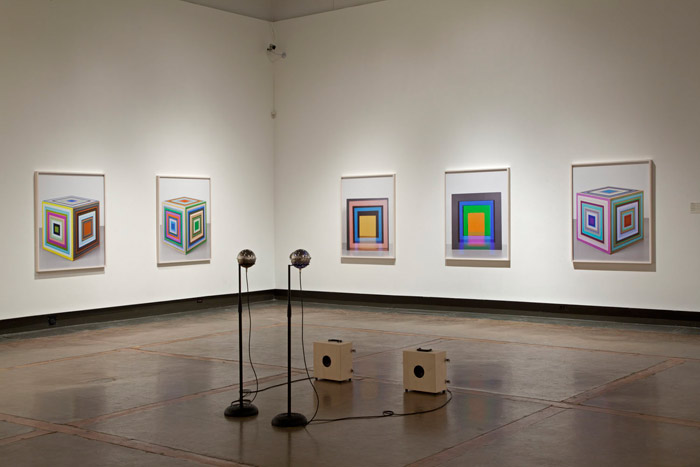The opening paragraph in the 1996 Nature magazine article “Circling the Inverse Square” (from which this exhibition takes it’s name) begins, “The one bit of physics that almost everyone knows is…” and continues with a fact that I did not (do not) know. Explain to me the premise that there are as many odd numbers as there are natural numbers and I become as baffled as comic foil Karl Pilkington, who famously dismissed the theory of an infinite number of monkeys eventually typing the complete works of Shakespeare with, “it wouldn’t happen”, because after all these years, “there hasn’t been one publication from a monkey”. I suspect I am not alone. For many, concepts such as infinity and nothing are understood the way a thirteen year old understands death—intellectually they know they’re going to die, but they haven’t exactly come to grips with it.
The six artists in curator Shannon Anderson’s KWAG exhibition share an interest in elucidating the imperceptible and the inconceivable, in “creating their own language as they explore the forces of time, space and logic that affect our everyday lives.” Geometric shapes, the shape of sound, voids and infinities populate an exhibition rich with both playful and serious explorations of our methodologies for making sense of the universe.
Joseph Albers told Elaine de Kooning in 1950 that “the concern of the artist is with the discrepancy between physical fact and psychological effect.” Jessica Eaton explores Alber’s notion (and some of the revolutionary ideas on color theory from his 1963 classic Interaction with Color) and combines them with Sol Lewitt’s exploration of the cube. In the five large format photographs in the exhibition, Eaton enacts a series of Photoshop-like manipulations, all performed in-camera. The artist documents a set of cubes that are painted white, black and grey. Using multiple exposures, the color hues in each image have been made by exposing the film to additive primaries of red, green and blue. What is most striking about the work is the unexpected painterly quality of the images, which was the result of hand-painting the cubes, leaving visible brush strokes. Eaton’s analogue approach to photography reaches beyond an academic technical exercise with results that are strikingly beautiful and expertly nuanced.
Sound artist Marla Hlady’s work often interprets sound as a physical phenomenon. Here she presents two of her Soundball works—stainless steel rice balls containing LED lights and audio loops that the audience activate. The exhibition also includes excerpts from her series of intricate, meditative drawings, which represent sound from an expressive, poetic perspective, using delicately drawn arrows on graph paper to delineate sound as intuitive graphic score.
Two works by Karilee Fuglem explore the relationship between the celestial body and the human body. Magnified photographs of the artist’s back are inverted as color negatives, the landscape of her skin resembling a spacescape, dotted with stars. A companion piece, Somewhere Behind My Heart, transposes these patterns of pores and moles onto an actual astral map, and plots them out on a web-like structure of hand-woven monofilament resembling an intricate but overgrown spider-web. The installation, anchored to the floor with a series of weights, disappears into the shadows, further suggesting its theoretical nature, imbuing the work as the artist says, “with an element of daydream…as part of its architecture.”
A messier approach to mapping, somewhat at odds with the otherwise subtle, minimal and sometimes delicate accompanying pieces in the show, is Richard Sewell’s Wherelocal/circling. The site-specific work, comprised mainly of hardware store materials, such as corrugated plastic, a large tarpaulin, cable ties, etc., explores how we locate objects in the world through both intuition and logic.
Charles Stankievech’s Gravity’s Rainbow turns Pink Floyd’s 1973 record Dark Side of the Moon into its own lightshow by projecting a thin beam across the vinyl grooves, creating an iridescent reflection reminiscent of Saturn’s rings. The soundtrack to the installation consists of the turntable stylus stuck in the run-out groove of the vinyl disc, repeating an endless white noise, not unlike the residual radiation from the Big Bang.
Adam David Brown’s White Noise is a 30 x 40 inch frame containing multiple layers of white paper, from which the artist has cut concentric ellipses creating a layered spiraling vortex that might also read as the numeral zero. Next to it, Eclipse invokes Joseph Beuys’ blackboards, with its patina of classroom use, except for a pristine erased black circle in the center, suggestive of a black hole. The surrounding dense layer of chalk scrawlings are equations and formulas by Isaac Newton, Stephen Hawking, and Albert Einstein.
Einstein’s remark that, “the most incomprehensible thing about the world is that it is comprehensible” fittingly embodies the spirit of curiosity and investigative play that runs through all of the work in the show. Bringing together works that use the human body, cultural artifacts, light, ambient sound, and everyday materials to make connections to the invisible world, Circling the Inverse Square attempts to reconcile the unknowable with the tangible.
By David Dyment
























